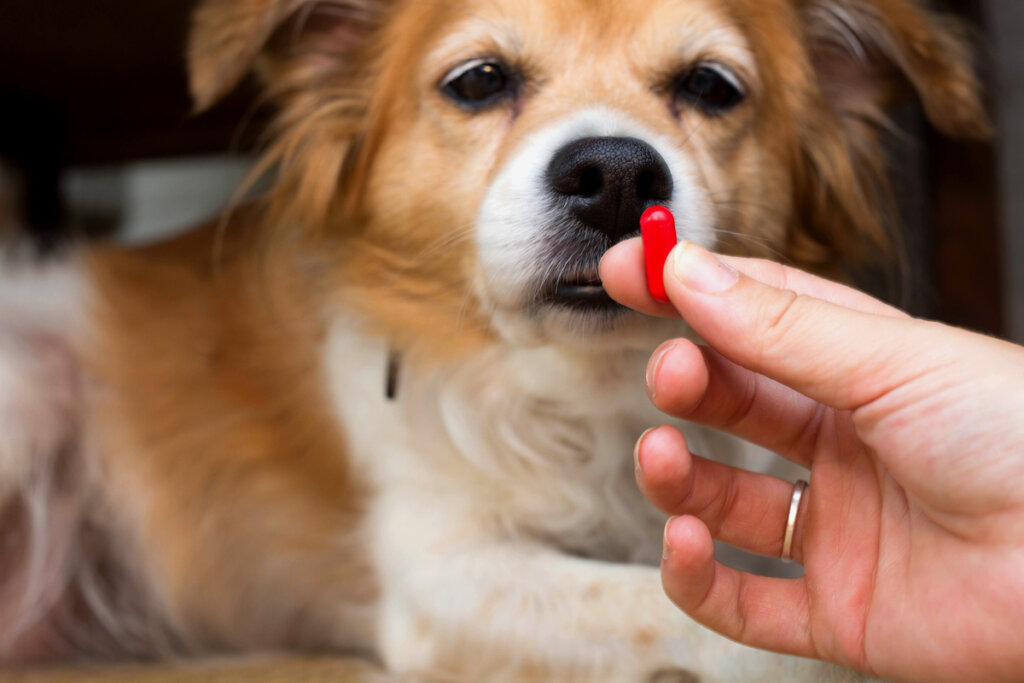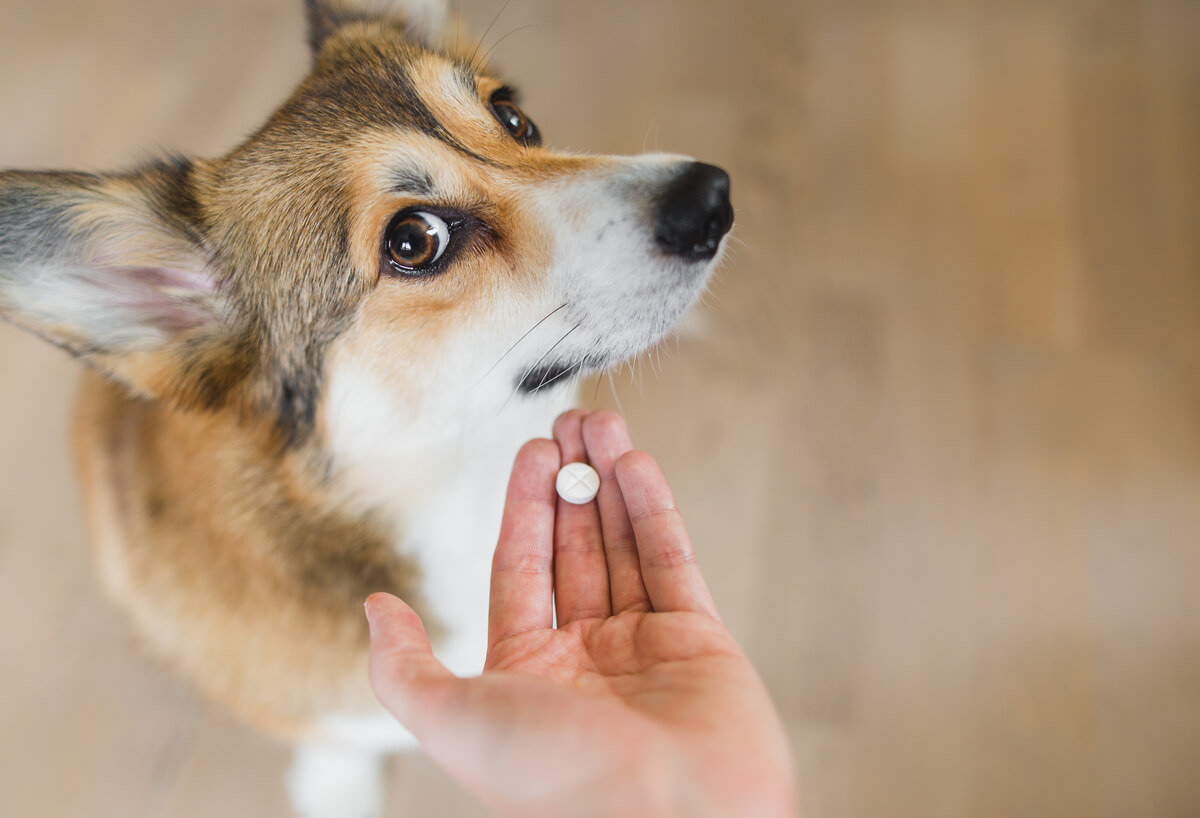Meloxicam for Dogs: Dosage and Recommendations

The field of pharmacology is so wide that, nowadays, drugs for human use are being used (in special dosages) in animals, and positive results are being obtained. The use of meloxicam in dogs is an example of the most successful cases in the treatment of canine problems and diseases.
Despite being such a popular drug, always remember to consult your veterinarian before starting any treatment for your pet. In the following lines, we’ll share with you the main recommendations when using meloxicam in dogs.
What is meloxicam for dogs?
Meloxicam is a drug belonging to the group of non-steroidal anti-inflammatory drugs (NSAIDs), whose function is to inhibit the synthesis of prostaglandins. These are substances involved in the inflammation process, so the effect of the drug is anti-inflammatory and analgesic. In addition, it usually has an antipyretic (which lowers fever) and antiexudative action once it has been assimilated.
The reason for administering meloxicam in dogs is most often when the animal has moderate to severe pain, or in situations where the musculoskeletal system is involved. It’s the drug of choice in acute diseases i.e. those that last a few days.
If your pet is going to undergo surgery, the use of meloxicam will probably be recommended, both before and after surgery, in order to avoid inflammatory processes. It’s also often used as an analgesic in dogs with joint problems.

Meloxicam dosage
Most drugs are administered in relation to the animal’s weight, in order to ensure their effectiveness. When meloxicam is used in dogs, the same rule is followed. The veterinarian will designate the amount of medication needed for your pet based on the following dosage:
- Initial dose: A single dose of 0.2 milligrams for each kilogram of weight of the dog.
- Subsequent doses: 0.1 milligrams for each kilogram of weight of the dog every 24 hours, during the remaining time of treatment.
In most canines treated with meloxicam, improvement is seen after approximately 4 to 5 days after starting administration. Usually, the treatment ends when there’s an improvement, or in 10 days at the most. However, this can be reduced as needed, so it’s important to follow the veterinarian’s instructions so that the therapeutic effect is as expected.
Formats of meloxicam for dogs
Because meloxicam is a drug widely used in canines, laboratories have developed different formats in order to facilitate its administration. The veterinarian will be the one to indicate the best way to offer the drug to dogs.
Meloxicam syrup is a thick liquid, which you can give to your pet orally or add to their food. There’s also meloxicam in tablet form, which is palatable and easy to swallow. Both presentations can be easily administered at home.
Depending on the case, meloxicam can also be used intravenously in dogs. This process will be performed by the veterinarian, as it’s necessary to set up an IV. This technique requires skill in its administration, to avoid secondary damage due to misapplication.
Contraindications and recommendations
The following are the main contraindications and recommendations that you should take into account when administering meloxicam to dogs:
- Don’t use in puppies under 6 weeks of age or weighing less than 4 kilograms.
- Avoid use in pregnant or lactating bitches.
- Don’t use in dogs with gastrointestinal, cardiac, renal, hepatic or circulatory problems.
- Avoid administration in dogs with signs of dehydration, hypovolemia, or hypotension (risk of renal toxicity).
- Don’t combine with other NSAIDs, glucocorticoids, diuretics, anticoagulants or antibiotics, unless recommended by the veterinarian.
- Discontinue treatment when signs of allergic reaction to the drug appear. Your pet may become hypersensitive to this drug.
Side effects
Although your dog may be a good candidate for a meloxicam-based treatment, we suggest that you keep them under constant observation, so that you can identify any change in their behavior. Each dog’s organism reacts differently to drugs, and there could be one of a number of side effects due to this NSAID.
Vomiting, diarrhea, anorexia, and lethargy usually occur during the first week of treatment as a response to the action of meloxicam or, failing that, due to an excess in its dosage. In intoxications, you will mainly observe digestive problems that can be aggravated depending on the case.
Blood in feces, bloody diarrhea and gastrointestinal ulcers are signs that can occur after administering meloxicam in dogs that haven’t eaten any food. Therefore, we recommend not to administer this drug on an empty stomach.

Now you know the many benefits that meloxicam has when prescribed for dogs and how easy it can be to administer it at home. However, we recommend you to always take this treatment under professional supervision. Remember: medications used correctly will be the best allies in the quick recovery of your pet.
All cited sources were thoroughly reviewed by our team to ensure their quality, reliability, currency, and validity. The bibliography of this article was considered reliable and of academic or scientific accuracy.
- Álvarez, I.(2009). Anestesia y Analgesia en el perro y gato. Madrid, España. Recuperado el 17 de abril de 2023, disponible en: http://www.colvema.org/WV_descargas/resumenanestesia-03062009230243.pdf
- Boehringer Ingelheim. (sf) Tratamiento analgésico-antiinflamatorio. España. Recuperado en mayo 2021, disponible en: https://www.boehringer-ingelheim.es/productos-veterinaria/animales-de-compania/animales-de-compania
- European Medicines Agency. (2022). Metacam. Recuperado el 17 de abril de 2023, disponible en: https://www.ema.europa.eu/en/medicines/veterinary/EPAR/metacam
- Hörstermann, D. (1999). Pharmacodynamic and pharmacokinetic aspects of the non-inflammatory non-steroidal agent meloxicam in dogs. DTW. Deutsche Tierarztliche Wochenschrift, 106(3), 94-100. https://europepmc.org/article/med/10220944
- Luna, S. P., Basílio, A. C., Steagall, P. V., Machado, L. P., Moutinho, F. Q., Takahira, R. K., & Brandão, C. V. (2007). Evaluation of adverse effects of long-term oral administration of carprofen, etodolac, flunixin meglumine, ketoprofen, and meloxicam in dogs. American journal of veterinary research, 68(3), 258-264. https://avmajournals.avma.org/view/journals/ajvr/68/3/ajvr.68.3.258.xml
- Mathews, K. A., Pettifer, G., Foster, R., & McDonell, W. (2001). Safety and efficacy of preoperative administration of meloxicam, compared with that of ketoprofen and butorphanol in dogs undergoing abdominal surgery. American journal of veterinary research, 62(6), 882-888. https://avmajournals.avma.org/view/journals/ajvr/62/6/ajvr.2001.62.882.xml?tab_body=pdf
- Molina D, V., Álzate V, D., Ruíz B, J., Urrea A, M., & Tobón J, J. (2014). Analgesic effect and side effects of celecoxib and meloxicam in canine hip osteoarthritis. Revista MVZ Córdoba, 19(3), 4289-4300. https://dialnet.unirioja.es/servlet/articulo?codigo=5447585
- Velázquez de Campos, O. J. (2020). Meloxicam, un AINE con características especiales. Salud (i) Ciencia, 23(8), 650-652. http://www.scielo.org.ar/scielo.php?script=sci_arttext&pid=S1667-89902020000100650
